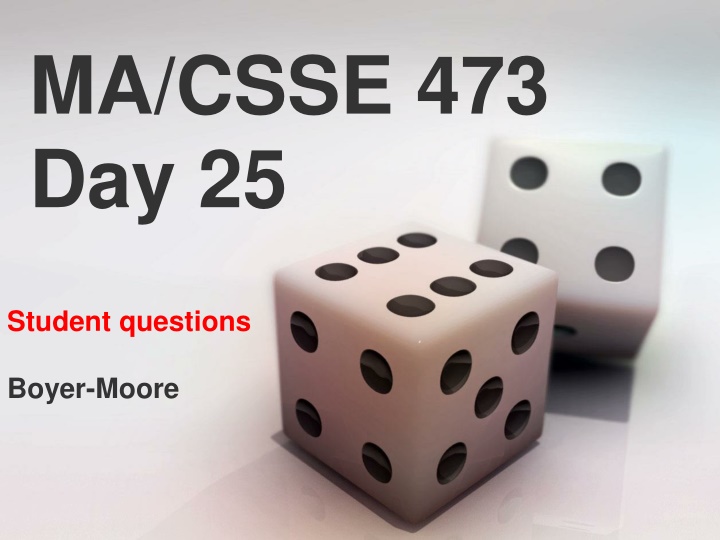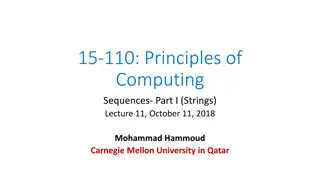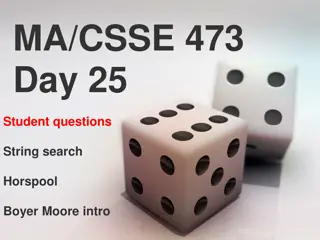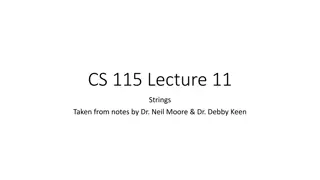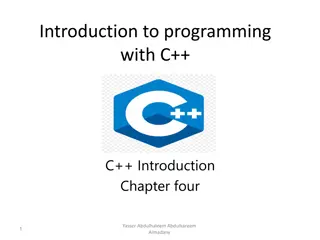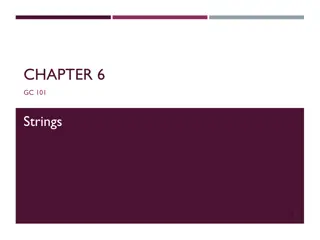Boyer-Moore Algorithm: Efficient String Searching Technique
The Boyer-Moore algorithm is a powerful string searching technique that compares pattern characters to text characters from right to left. By precomputing shift amounts in two tables (bad-symbol and good-suffix tables), it optimizes the search process for finding substrings efficiently. This algorithm considers matched characters before a mismatch occurs, resulting in effective pattern shifting strategies. Learn how Boyer-Moore enhances text searching and efficiently handles mismatches.
Download Presentation

Please find below an Image/Link to download the presentation.
The content on the website is provided AS IS for your information and personal use only. It may not be sold, licensed, or shared on other websites without obtaining consent from the author.If you encounter any issues during the download, it is possible that the publisher has removed the file from their server.
You are allowed to download the files provided on this website for personal or commercial use, subject to the condition that they are used lawfully. All files are the property of their respective owners.
The content on the website is provided AS IS for your information and personal use only. It may not be sold, licensed, or shared on other websites without obtaining consent from the author.
E N D
Presentation Transcript
MA/CSSE 473 Day 25 Student questions Boyer-Moore
Boyer Moore Intro When determining how far to shift after a mismatch Horspool only uses the text character corresponding to the rightmost pattern character Can we do better? Often there is a partial match (on the right end of the pattern) before a mismatch occurs Boyer-Moore takes into account k, the number of matched characters before a mismatch occurs. If k=0, same shift as Horspool. So we consider 0 < k < m (if k = m, it is a match).
Boyer-Moore Algorithm Based on two main ideas: compare pattern characters to text characters from right to left precompute the shift amounts in two tables bad-symbol table indicates how much to shift based on the text s character that causes a mismatch good-suffix table indicates how much to shift based on matched part (suffix) of the pattern
Bad-symbol shift in Boyer-Moore If the rightmost character of the pattern does not match, Boyer-Moore algorithm acts much like Horspool s If the rightmost character of the pattern does match, BM compares preceding characters right to left until either all pattern s characters match, or a mismatch on text s character c is encountered after k > 0 matches text pattern k matches bad-symbol shift: How much should we shift by? d1 = max{t1(c ) - k, 1} , where t1(c) is the value from the Horspool shift table.
Boyer-Moore Algorithm After successfully matching 0 < k < m characters, with a mismatch at character k from the end (the character in the text is c), the algorithm shifts the pattern right by d = max {d1, d2} where d1 = max{t1(c) - k, 1} is the bad-symbol shift d2(k) is the good-suffix shift Remaining question: How to compute good-suffix shift table? d2[k] = ???
Boyer-Moore Recap 2 n length of text m length of pattern i position in text that we are trying to match with rightmost pattern character k number of characters (from the right) successfully matched before a mismatch After successfully matching 0 k < m characters, the algorithm shifts the pattern right by d = max {d1, d2} where d1 = max{t1[c] - k, 1} is the bad-symbol shift (t1[c] is from Horspool table) d2[k] is the good-suffix shift (next we explore how to compute it)
Good-suffix Shift in Boyer-Moore Good-suffix shift d2 is applied after the k last characters of the pattern are successfully matched 0 < k < m How can we take advantage of this? As in the bad suffix table, we want to pre-compute some information based on the characters in the suffix. We create a good suffix table whose indices are k = 1...m-1, and whose values are how far we can shift after matching a k-character suffix (from the right). Spend some time talking with one or two other students. Try to come up with criteria for how far we can shift. Example patterns: CABABA AWOWWOW WOWWOW ABRACADABRA
Boyer-Moore example (Levitin) _ A B C D E F G H I J K L M N O P Q R S T U V W X Y Z 1 2 6 6 6 6 6 6 6 6 6 6 6 6 3 6 6 6 6 6 6 6 6 6 6 6 6 B E S S _ K N E W _ A B O U T _ B A O B A B S B A O B A B d1 = t1(K) = 6 B A O B A B d1 = t1(_)-2 = 4 d2(2) = 5 B A O B A B d1= t1(_)-1 = 5 d2(1) = 2 3 BAOBAB 5 4 BAOBAB 5 5 BAOBAB 5 k d2 2 5 pattern 1 2 BAOBAB BAOBAB B A O B A B (success)
Boyer-Moore Example (mine) pattern = abracadabra text = abracadabtabradabracadabcadaxbrabbracadabraxxxxxxabracadabracadabra m = 11, n = 67 badCharacterTable: a3 b2 r1 a3 c6 x11 GoodSuffixTable: (1,3) (2,10) (3,10) (4,7) (5,7) (6,7) (7,7) (8,7) (9,7) (10, 7) abracadabtabradabracadabcadaxbrabbracadabraxxxxxxabracadabracadabra abracadabra i = 10 k = 1 t1 = 11 d1 = 10 d2 = 3 abracadabtabradabracadabcadaxbrabbracadabraxxxxxxabracadabracadabra abracadabra i = 20 k = 1 t1 = 6 d1 = 5 d2 = 3 abracadabtabradabracadabcadaxbrabbracadabraxxxxxxabracadabracadabra abracadabra i = 25 k = 1 t1 = 6 d1 = 5 d2 = 3 abracadabtabradabracadabcadaxbrabbracadabraxxxxxxabracadabracadabra abracadabra i = 30 k = 0 t1 = 1 d1 = 1
Boyer-Moore Example (mine) First step is a repeat from the previous slide abracadabtabradabracadabcadaxbrabbracadabraxxxxxxabracadabracadabra abracadabra i = 30 k = 0 t1 = 1 d1 = 1 abracadabtabradabracadabcadaxbrabbracadabraxxxxxxabracadabracadabra abracadabra i = 31 k = 3 t1 = 11 d1 = 8 d2 = 10 abracadabtabradabracadabcadaxbrabbracadabraxxxxxxabracadabracadabra abracadabra i = 41 k = 0 t1 = 1 d1 = 1 abracadabtabradabracadabcadaxbrabbracadabraxxxxxxabracadabracadabra abracadabra i = 42 k = 10 t1 = 2 d1 = 1 d2 = 7 abracadabtabradabracadabcadaxbrabbracadabraxxxxxxabracadabracadabra abracadabra i = 49 k = 1 t1 = 11 d1 = 10 d2 = 3 abracadabtabradabracadabcadaxbrabbracadabraxxxxxxabracadabracadabra abracadabra 49 Brute force took 50 times through the outer loop; Horspool took 13; Boyer-Moore 9 times.
Boyer-Moore Example On Moore's home page http://www.cs.utexas.edu/users/moore/best- ideas/string-searching/fstrpos-example.html
